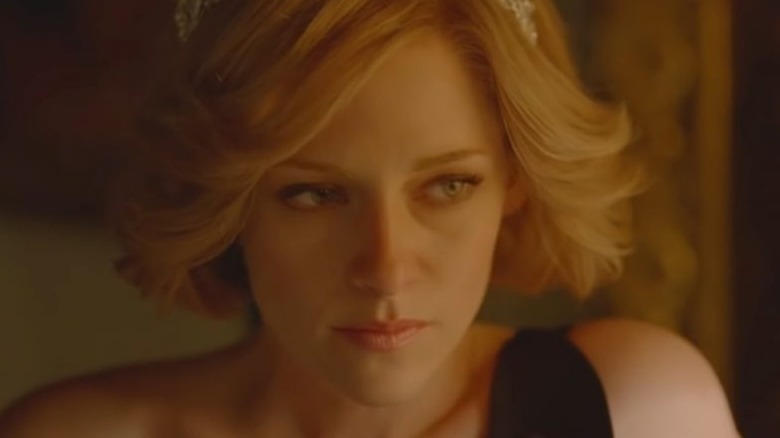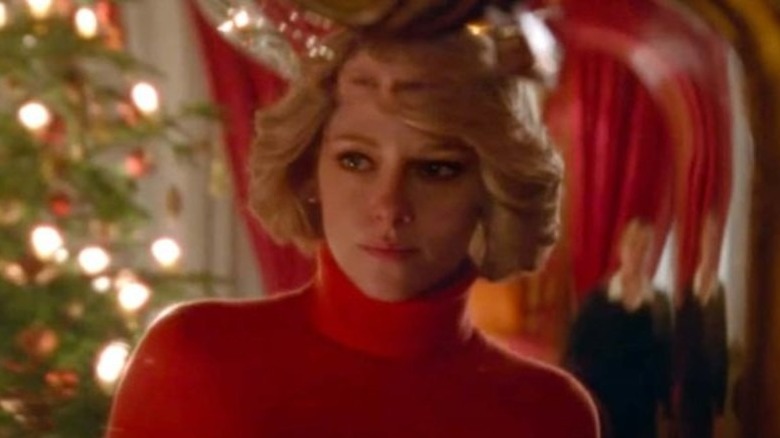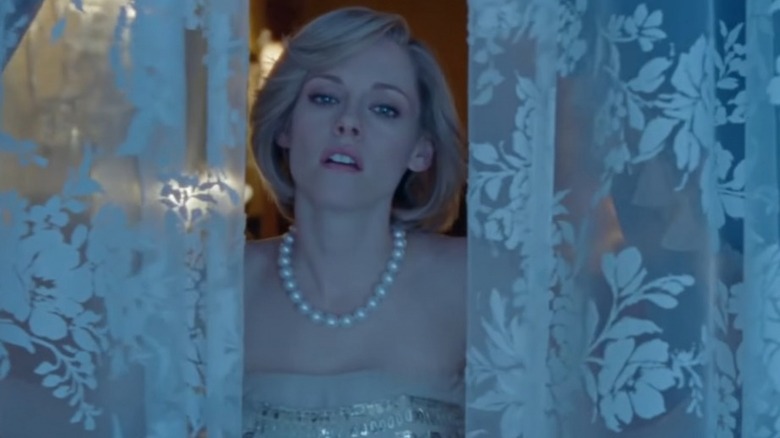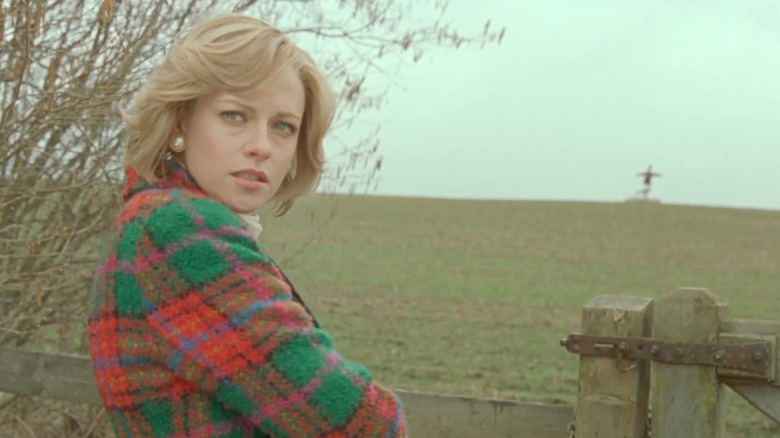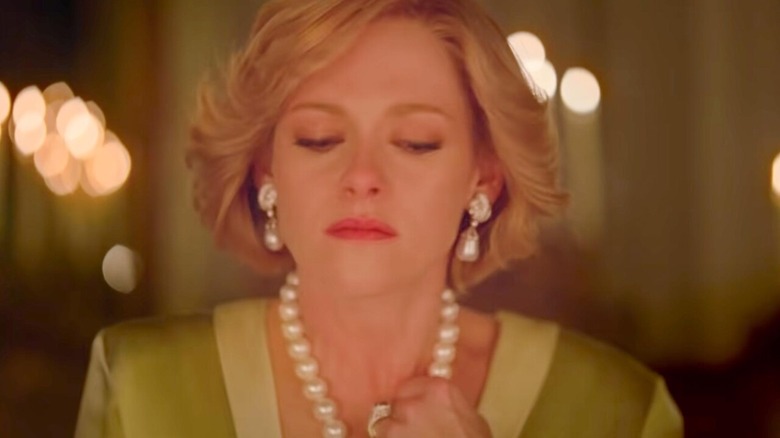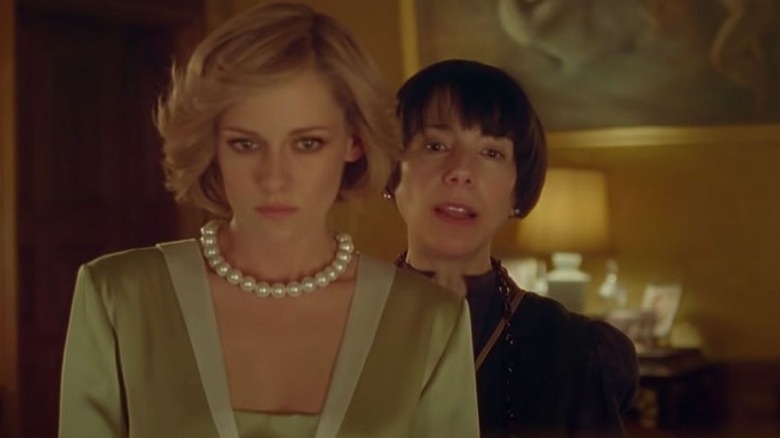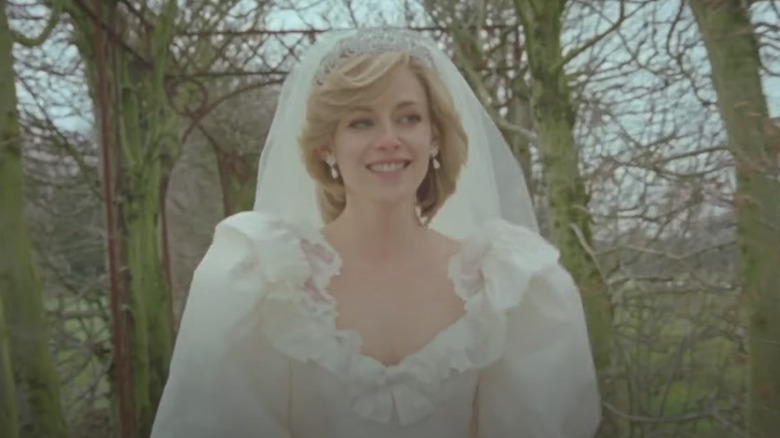The Ending Of Spencer Explained
Pablo Larraín's "Spencer" stars Kristen Stewart as the late Princess Diana of Wales. Released in 2021, the film is the latest project using the Princess as its centerpiece, however this story offers something new and exciting. Being described in the film's opening as "a fable from a true tragedy," the movie tells a largely fictional story inspired by the real life of Princess Diana. This is extremely different from documentaries about the Princess such as HBO's "Diana: 7 Days That Shook the Windsors", biopics like 2017's "Diana" starring Naomi Watts, or even Netflix's drama series "The Crown" about the royal family.
Larraín gives us a fresh take on Princess Diana unlike we have seen before with an incredible, Oscar-worthy performance from Stewart. "Spencer" follows Diana through three days spent with the royal family in 1991 — Christmas Eve, Christmas Day, and Boxing Day. With this setup, "Spencer" depicts what life may have been like for the Princess, trying to bear through the holidays while dealing with the Prince's affair with Camilla Duchess of Cornwall (per Insider) and a family she feels isolated from. Throughout the film, Diana struggles with her sense of belonging and identity, only showing moments of happiness when reminiscing on her childhood or spending time with her children.
The film employs a heavy usage of symbolism in conveying its story and message — all the way up until the very end. Here's what it all means.
Spencer establishes a specific tone immediately
Right at the start of "Spencer," a tone is quickly established: The film opens with military guards bringing in supplies and food for the royals during their stay at the Queen's Sandringham Estate. They set the food down in the Estate's kitchen in military fashion, operating like robots, putting down the crates of food one by one, and standing at attention. This is followed by the kitchen staff receiving instructions before the royals arrive, once again echoing military style. The instructions sound like commands and the staff is expected to fall in line. This establishes the Estate as a cold place, functioning more like a military compound than a lavish vacation stay for the holidays.
While this is all happening, a lost Diana is trying to find her way to the Estate. She opted to drive herself rather than be escorted. This builds anxiety and mystery as Diana slowly, but surely makes her way to the Estate. In fact this all happens over the course of about twenty minutes before a title screen finally appears on screen, slowly building the tension. The film is based in her perspective, so we not only feel the anxiety she experiences approaching the Estate (and upon her arrival), but also the anxiety of the Estate itself. The Estate feels grand and overbearing, yet you're unable to avoid the feeling that someone is always watching and listening, waiting for you to slip up.
In this case, that would be the royal family watching Diana. This is all reinforced by a sign in the background when she arrives in the fourier reading, "Keep very quiet. They can hear you."
Diana is literally and metaphorically isolated
With the rigid setting of the Estate being established, you begin to feel a sense of isolationism. Diana is always far removed from the royal family, staying in her room or wandering off to the house she grew up in that is located nearby. The film is shot in a way that only aids in furthering this feeling of isolationism. The camera is always focused on Diana: Even in scenes in which there are others near her, the camera still seems to only be focused on her. Furthermore, when she does share a scene with someone, there is a distance that is created by literally not being near the other actor, but by also not capturing them in the same shot, but individually.
Creating this sense of isolationism is done to metaphorically capture the literal isolation Diana is experiencing. She feels lonely in this huge Estate because she feels as if she does not belong to this family nor do they seem to even want her in their presence. She also feels isolated from her husband, Prince Charles (Jack Farthing), as she knows of the affair he is having with Camila Duchess of Cornwall.
The only time this feeling of isolation escapes the screen is when Diana is around those closest to her such as her children and a servant Maggie (Sally Hawkins) whom she confides in. They are shot in frame with her rather than distanced and the atmosphere in these scenes are warmer than the coldness felt with others.
Spencer's symbolism game is strong
As mentioned before, "Spencer" is packed full of symbolism, all of which ties off satisfactorily in the ending. Firstly, there are the pheasants that appear throughout the story, and they represent Diana. During the opening sequence of "Spencer," when the guards are driving in with the royals' food supply, there is a dead pheasant in the middle of the road. This pheasant is nearly driven over and trampled with every single military vehicle that passes over it, but never actually gets touched by a tire. This adds to that anxiety that was described in the beginning of the film while also foreshadowing what lies ahead for Diana herself. Pheasants return at the end of the film during Boxing Day hunting, but more on that later.
Besides pheasants, there is also Diana's pearl necklace gifted to her by Prince Charles. These pearls play a substantial role in the film. While being dressed from Christmas Eve dinner, Diana holds the pearl necklace and informs some staff that she knows the Prince also gifted the same set of pearls to his mistress. Following this, during the film, we see her scratch and pull at the necklace — a literal expression of her anxiety and discomfort, however it also symbolizes how she feels like a prisoner and how she feels suffocated. She not only has to stay literally quiet because of fears she may be heard or it may be improper, but she feels she has to remain quiet on the affair. The pearls both symbolize the affair, but also the invisible shackles of suffocation she endures which leads to one of the film's most memorable scenes.
Spencer's pearl scenes and their meaning
One of the most talked about scenes from "Spencer" is the Christmas Eve dinner with the royals. Anxiety and discomfort can be felt as Diana sits at the table, clearly unwanted by the other guests, including Prince Charles, who all but ignore her presence. An eerie and unsettling atmosphere slowly starts to build as Diana exchanges looks with her husband and the Queen (Stella Gonet), who is staring her down. Diana begins to pick and claw at her pearl necklace, begging to be free from it, and she eventually breaks it off, sending pearls into the soup in front of her.
She then begins to eat the soup and, in fact, savors it, taking spoonful after spoonful. Unexpectedly, rather than toss the pearls out, she bites down on a single pearl and swallows it, all while staring back at the queen. This scene is a standout, not only for its shocking and melodramatic nature, but for what it all represents. Firstly, it symbolizes Diana wanting to release herself from this imaginary prison she's in, it also acts as an effective "eff you" to the queen. Secondly, throughout the film Diana endures behaviors of bulimia (accurate to the real-life Diana, per Vogue), something this scene is clearly commenting on.
After the scene ends, it is revealed to be a fantasy though — she is later seen with the pearl necklace, intact — but it sets up another pearl scene at the film's end. There, Diana escapes the Estate on Christmas, running off to her childhood home. While there, she finally breaks off the pearl necklace for good, as she'd dreamed of doing earlier. This shows Diana finally letting herself free, and sets up the climax.
Spencer's ending ties back to a red coat
Through the entirety of "Spencer," and all of Diana's struggles, there is one thing that Diana keeps going back to — a red coat. In the opening of the film, when Diana is seeking directions to the Estate, she notices an old scarecrow she dressed as a child. She takes off the red coat it's wearing, because it was her father's, and she has Maggie repair it once at the Estate.
While Maggie and her children do help keep Diana somewhat grounded and from completely losing her mind, they are not always around during the whole film. In fact, Maggie is shipped off for a good majority of the film as a sort of punishment, presumably by the Queen, because Diana was late to the Estate. However, what does comfort Diana is that red coat. She finds herself coming back to it over and over again. The coat reminds her not only of her father and her childhood, but it reminds her of herself — who she is as a person, when not enduring her prisoner lifestyle as a member of the royal family.
This is why the red coat, in contrast to the pearl necklace, is so essential to the ending. At the conclusion of "Spencer," Diana, now wearing her father's red coat, interrupts the pheasant hunting that the royals are partaking in for Boxing Day. She stands in the middle of the field and announces she will be going home and she is taking her children with her, who she didn't want participating in the hunting anyways. The three of them head to London to spend the rest of Boxing Day. In doing this, Diana has ended the hunt of herself from the royals.
Spencer is a story of liberation
Everything that happens in "Spencer," from Diana breaking her pearls, finding that red coat, or deciding to take her children to London, all lead to one place: At the end of the film, Diana is now free, "Spencer" is the story of her liberation. By leaving the royal family and taking her children with her, she has now escaped from enduring more suffering at their hands, and has hopefully prevented her children from having the same fate.
The ending, which shows a fully liberated Diana, pays off how the film before shows her so desperately wanting to return to her old self (the red coat). The title of the film, "Spencer," also secretly hints at this ending, as Spencer is Diana's birth name. This story is not about the glamorized idea of Diana Princess of Wales, but simply about Diana Frances Spencer, the woman and mother who just wants to be herself again.
Just before the credits roll on "Spencer," we see Diana smile at her children and take in her newly found freedom. So, while by the ending she is already free, the meaning of the ending, and what it implies, is that Diana lives the rest of her life (until its tragic end) free.
